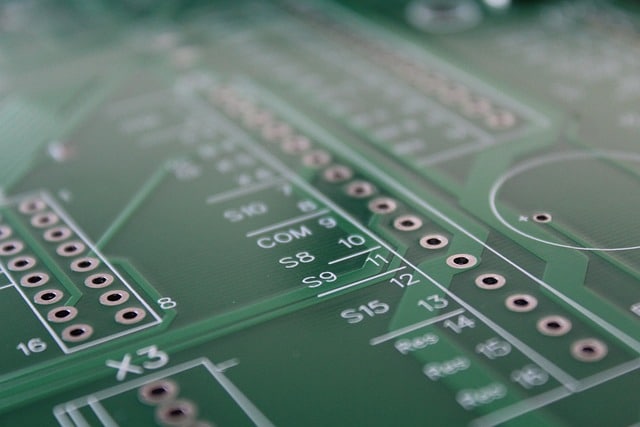The PCB industry commonly uses substrates composed of glass fiber impregnated with resin. One of such PCB substrate material is G10. While the G in the name stands for glass fiber, the figure 10 indicates that glass fiber content in the substrate amounts to 10% of the total. According to Rush PCB Inc, the G10 material offers very good insulation, and resistance to wear and corrosion. In comparison with regular glass fiber, epoxy based glass fiber offers the PCB manufacturer excellent properties such as high elastic modulus, high tensile strength, excellent impact resistance, very good chemical stability, high temperature stability, good fatigue resistance, and more. Many industries use G10 PCBs including aviation, agriculture, construction, aerospace, and chemical industries.
The molecular structure of the G10 material consist mostly of reactive epoxy groups. This allows them to cross-link with various types of curing agents. This feature allows creation of three-way network structures from insoluble polymers. Most epoxy resins are basically organic polymer mixtures that consist of two or more epoxies bunching within the molecule. Although there are a few exceptions, especially those with comparatively low molecular mass.

Similar to FR4, the G10 glass epoxy material with natural resins has color varying from light yellow to light green. The most popular G10 laminate grade is typically a continuous fiberglass fabric that has been impregnated with an epoxy adhesive. The electronics industry uses epoxy resin as the most versatile plastic, mainly because of its features of nearly zero water absorption, and excellent insulation properties. Apart from the above, epoxy resins feature perfect dimensional stability (shrinkage less than 1%) and exceptional adhesion properties, along with splendid electrical insulating features.
G10 offers extremely low dielectric loss performance, high mechanical strength, and superior electrical insulation, both when wet or dry. FR4 is a grade of G10 with flame retardant capabilities, and this is the main difference between FR4 and NEMA G10. Therefore, PCB manufacturers can easily and safely replace G10 substrates with FR4, but not the reverse.
Comparison of G10 and FR4 Materials
- Both FR4 and G10 are high-pressure industrial PCB substrates consisting of glass fabric impregnated with epoxy resin.
- The major difference between FR4 and G10 is in their resin composition.
- G10 epoxy resin is a composite of epichlorohydrin and bis phenol A.
- In FR4 epoxy resin, tetrabromo bis phenol A replaces a small part of bis phenol A.
- Because of the above replacement, FR4 laminate is more flame retardant.
- G10 and FR4 are very similar in properties.
- Glass transition temperature or Tg is relatively the same for both FR4 and G10.
Advantages of G10 Epoxy Substrates
Diverse Forms—G10 epoxy may contain a wide variety of resins, curing agents and modifier systems to achieve diverse shape requirements, suitable for almost any application, varying from low viscosity to high temperature solids.
Easy to Solidify—By using a variety of curing materials, it is possible to cure the G10 epoxy resin systems in temperatures from 0 to 180 C. However, for specific environments with high temperatures, the recommendation is to use high Tg materials.
Strong Adhesive Force—G10 epoxy materials exhibit high adhesion to several materials, as they contain ether and hydroxyl bonds that are inherent in molecular chains of epoxy resins. G10 epoxy resins feature low shrinkage during the curing process and create very little inherent stress. This helps to improve the bonding strength.
Low Rate of Contractibility—G10 epoxy resins react to their curing materials. The reaction can be from direct addition of epoxy catalogs or open loop polymerization in the resin molecule. However, there is nor release of water or any other volatile material. In comparison with unsaturated polyester resins and phenolic resins, G10 epoxy resins shrink less than 2% during curing.
G10 Epoxy Substrates—Technical Specifications
| G10 — Technical Specifications | |
| Technical Parameter | Specifications |
| Flame Retardant | HB |
| Bending Strength (normal), Perpendicular Layer | ≽340 Mpa |
| Bending Strength (150±2 °C), Perpendicular Layer | ≽340 Mpa |
| Impact Strength, Parallel Layer | 66.7 KJ/m2 |
| Insulation Resistance (immersion in water D-24/23) | ≽5.0×102 Ω |
| Electrical Strength, Vertical Layer | ≽10.7 MV/m |
| Breakdown Voltage, Parallel Layer | ≽40 kV |
| Relative Dielectric Constant (1 MHz) | ≼5.5 |
| Dielectric Loss Angle | 3.3×10-2 |
| Water Absorption (D-24/23, Plate Thickness 1.6 mm) | 6.5 mg |
Comparing G10 and G11 Epoxy Substrates
G10 and G11 are both laminated composites of glass fiber with resin impregnation. While the alphabet G stands for glass fiber, the number represents its percentage content.
G10 Epoxy Board
G10 epoxy board is aqua green in color. The manufacturer dips the E-glass fiber cloth in the epoxy resin and presses it. The G10 epoxy board does not contain halogen elements, and hence, it cannot pollute the environment.
G10 Important Parameters
- Glass transition temperature 130 °C
- Electric Breakdown Voltage >60 kV
- Flame Retardant UL94-V0
G10 Composition—Alkali-free glass-fiber cloth impregnated with epoxy resin, flame retardant, adhesive, and other additives added with hot pressing.
G10 Applications—for switchgear, transformers, and explosion-proof electrical appliances.
G11 Epoxy Board
G10 epoxy board is a hard insulating material.
G11 Important Parameters
- Glass transition temperature 175 °C
- Resistance to water – high
G11 Composition—Alkali-free glass-fiber cloth impregnated with epoxy resin, flame retardant, adhesive, and other additives added with hot pressing.
G11 Applications—used for humid environments, manufacture of high-voltage switches, insulation oil, high-voltage GIS.
Conclusion
Rush PCB Inc recommends having a preliminary understanding of the G10 epoxy board material for application in the PCB manufacturing process. For greater details regarding use, content control, and application, please consult our professional team or visit our website contact us page.





